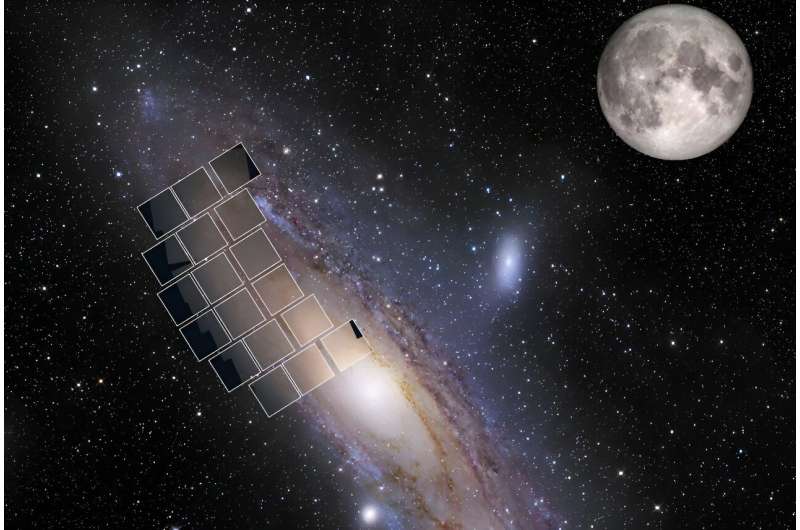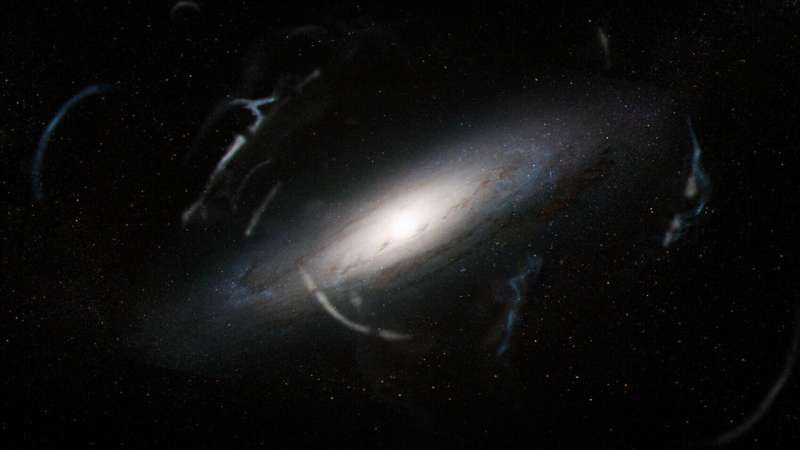This article has been reviewed according to Science X's editorial process and policies. Editors have highlighted the following attributes while ensuring the content's credibility:
fact-checked
peer-reviewed publication
trusted source
proofread
Searching for dark matter in gaps between stars

Although dark matter makes up about 27% of the universe, astronomers have been unable to observe it directly.
Now, in a new study, an international team of researchers including Northwestern University astrophysicists has found that upcoming images from NASA's Nancy Grace Roman Space Telescope (set to launch by May 2027) may hold vital clues to understanding the elusive material.
In the hunt for dark matter, some astrophysicists previously have focused on the gaps in streams of stars—areas where the structures are so thin that it's possible to spot disturbances created by clumps of dark matter. But, so far, astronomers have only examined these gaps in the Milky Way. With the Roman Space Telescope taking images of our neighboring Andromeda galaxy, researchers will greatly expand their growing sample of thin stellar streams, potentially leading to more information about the concrete properties of dark matter.
The study has been accepted for publication by The Astrophysical Journal. A preprint currently is available online. It marks the first exploration of the prospects of finding gaps within streams of stars beyond our own Milky Way galaxy.
"There are stellar streams in our own galaxy, where we see gaps that might be due to dark matter," said Northwestern's Tjitske Starkenburg, who co-authored the study. "But these gaps also can be formed by other means. Our new study makes the case that we will be able to observe these gaps in nearby galaxies other than our own. That will give us better statistics on these gaps, which ultimately will help us better understand the possible existence and properties of dark matter clumps."
Starkenburg is a research assistant professor at Northwestern's Center for Interdisciplinary Exploration and Research in Astrophysics (CIERA). Christian Aganze, a postdoctoral fellow at Stanford University, is the study's lead author.
Assumed to be a particle, dark matter cannot yet be observed directly because it does not emit, reflect, refract, or absorb light. Because no one can see it, researchers have to look for other clues to determine if it's actually there.
"We see dark matter's effect on galaxies," Aganze said. "For example, when we model how galaxies rotate, we need extra mass to explain their rotation. Dark matter may provide that missing mass."

Astronomers are particularly hopeful that clues might be hidden within the elongated streams of stars dangling from globular clusters, tightly bound groups of dozens to millions of stars. Researchers say clumps of dark matter can punch through stellar streams to create gaps. By examining these gaps, astronomers aim to uncover signs of dark matter.
"The reason these streams are most interesting to see the effects of these dark matter clumps is twofold," Starkenburg said. "First, these streams 'live' in the extreme outer regions of a galaxy, where there otherwise is very little structure. And second, these streams are intrinsically very thin because they formed from dense clusters of stars, which means that you can see gaps or any disturbance much more easily."
To date, existing space- and ground-based telescopes have limited the search to a small number of globular cluster streams within the Milky Way. But the Roman Space Telescope, which will be located 1 million miles from Earth, will enable astronomers to search nearby galaxies for globular cluster streams for the first time.
Roman's Wide Field Instrument has 18 detectors that will produce images 200 times the size of those produced by the Hubble Space Telescope's near-infrared camera—and at a slightly greater resolution.
In the new study, Starkenburg, Aganze, and their collaborators simulated streams of stars, allowed them to interact with dark matter clumps to create gaps, and then generated mock observations of these gaps. Ultimately, the team concluded that these gaps should be detectable in the Roman Space Telescope's forthcoming images. They also estimate that the new telescope will efficiently deliver this data within as little as one hour of observing time.
When the time comes, the researchers also plan to examine the halo of dark matter surrounding Andromeda. While dark matter halos encircle all galaxies, including the Milky Way, the researchers suspect they may find evidence of smaller sub-halos, which current models predict.
"We expect smaller dark matter sub-halos to interact with globular cluster streams," Starkenburg said. "If these sub-halos are present in other galaxies, we predict that we will see gaps in globular cluster streams that are likely caused by these sub-halos. That will give us new information about dark matter, including which kinds of dark matter halos are present and what their masses are."
Starkenburg is already laying the groundwork for the investigation into dark matter through a related project.
"That team plans to model how globular clusters form into stellar streams by developing a much more detailed theoretical framework," she said. "We will go on to predict the origins of stream-forming globular clusters and whether these streams will be observable with Roman."
More information: Christian Aganze et al, Prospects for Detecting Gaps in Globular Cluster Stellar Streams in External Galaxies with the Nancy Grace Roman Space Telescope, arXiv (2023). DOI: 10.48550/arxiv.2305.12045
Journal information: Astrophysical Journal , arXiv
Provided by Northwestern University





















